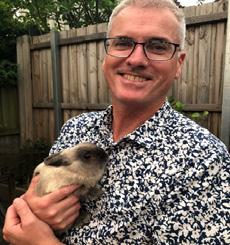
3 minute read
NZEVA President Report Brendon Bell
Brendon Bell, NZEVA President nzevapresident@gmail.com
This is my first EVA President Report, and I can already see there are big boots to fill here. I am still learning the ropes and am grateful to have immediate past president Andrea Ritmeester to help me. It’s been a quiet start for me compared to the turmoil of 2020/21, which has been appreciated. We also have an EVA Executive Committee with some old and some new faces. Secretary is Katie Kindleysides now in Canterbury and treasurer remains Roisin McQuillan of Matamata. The rest of the executive is Lucy Holdaway in Cambridge, Alex Fowler in Auckland, Melissa Sim in Pukekohe, Grace Reed here in Invercargill and Pip Hendron in Masterton: see page 5 for mini profiles of your EVA Executive members It was great to be at the recent conference in Christchurch in June - one of the few and maybe the only current, faceto-face, national veterinary conferences in the world. We hit a small speed bump with the Wellington NZVA staff being recalled due to the CoViD-19 scare, but apart from this the conference went extremely smoothly. Keynote speakers Ben Sykes and Katharyn Mitchell provided some easy to understand and stimulating discussions. Thanks must go to the tireless efforts of Alanna Zantingh and her committee for the great organisation. As an organisation we face a new way of doing business and a new financial structure. This comes by way of the NZVA’s newly introduced all-inclusive membership model. There are merits to this new model and although many of us still have some misgivings we are looking to embrace change: the only constant. At the time of writing the Entry Level Equine Dental Course is about to start in Christchurch. The increasing number of older pleasure horses many of us are treating coupled with recent changes to Animal Welfare legislation has seen an increase in equine dental work for many of us. This course will be a great grounding for practitioners looking to get involved in this burgeoning field. The days are already getting longer, so soon enough it will be spring and breeding time. Enjoy the quiet while it lasts. Kind regards, Brendon Bell nzevapresident@gmail.com
Khajeh A et al. Effectiveness of nuchal ligament autograft in the healing of an experimental superficial digital flexor tendon defect in equid. Vet Res Forum. 2021; 12(1): 53-61. DOI 10.30466/vrf.2019.97919.2330
A 3x1.5 cm segment of the funicular part of the nuchal ligament [NL] was excised and implanted into a full thickness defect created in the left fore superficial digital flexor (SDF) tendon in eight healthy donkeys. No weight-bearing lameness or clinical changes observed in the necks were detected following harvesting and implantation. Mild to moderate adhesions were detected in the dorsal surface of the SDF tendon. There was no significant difference in the echogenicity and fibre alignment on days 90 and 120 after surgery. Treatment significantly amplified the collagen diameter and enhanced collagen fibril diameter and density compared to the right SDF tendon. The transplanted tissue was mostly in the remodelling or maturation phase by day 120 postoperatively. It appears that the nuchal ligament is biocompatible and almost biodegradable and is effective in tendon healing without metaplasia or tissue rejection.
Hedia M et al. Hemodynamic changes in cytokines, chemokines, acute phase proteins and prostaglandins in mares with subclinical endometritis. Theriogenol. 2021; 171: 38-43. DOI 10.1016/j.theriogenology.2021.05.011
Forty-nine mixed-breed mares of known reproductive history were allocated into healthy (control), chronic endometritis (ChE), and subacute suppurative endometritis (SSE) Groups [n = 12, 26 and 11 mares, respectively]. Serum concentrations of IL-6, IL-8 and IL-10 and plasma PGF-2α concentrations were increased (P < 0.01) in mares with SSE compared to healthy mares. Serum concentrations of IL-6 (P < 0.05) and IL-10 (P < 0.05) were elevated in the ChE group compared to the healthy group whereas SAA (P < 0.01) and PGE-2 (P < 0.05) were higher in healthy mares compared to ChE and SSE mares. However, serum concentrations of IL-1β and TNF-α were not significantly different among groups. Serum IL-6/IL-10 and IL-6/TNF-α concentrations, as well as plasma PGE-2/PGF-2α ratio, may yield novel diagnostic markers for chronic subclinical endometritis.







